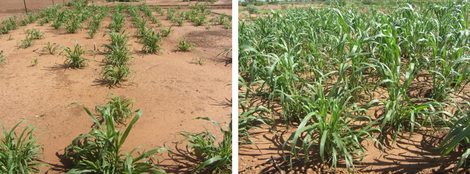Building resilience against drought: the soil-water management perspective
Many regions are suffering from agricultural drought, i.e. the shortage of available water for plant growth.
This is not only caused by lack of rain, but mostly by an imbalanced partitioning of rainfall, resulting from inappropriate soil-water management (SWM) and physical soil degradation.
Outreach to developing countries
We are developing and testing rain fed and irrigated conditions in Ethiopia, Iran, Kenya, Malawi, Niger, and Thailand to optimize SWM practices.
Recent developments allow to use fully coupled surface/subsurface models to describe water flow at plot, field and catchment scale. This facilitates evaluating and optimizing the design of SWM practices and computing water balance components for current, past and future climates.
Same soil texture, same topography, same weather conditions (thus same rainfall, no irrigation), same crop (and variety), same time, but … different soil moisture (field near Niamey, Niger).
Impact
Optimized soil-water management not only increases crop production (often more than 50%, as demonstrated in our projects), but also reduces land degradation and contributes to a regreening of the landscape, and thus rendering ecosystem services.

